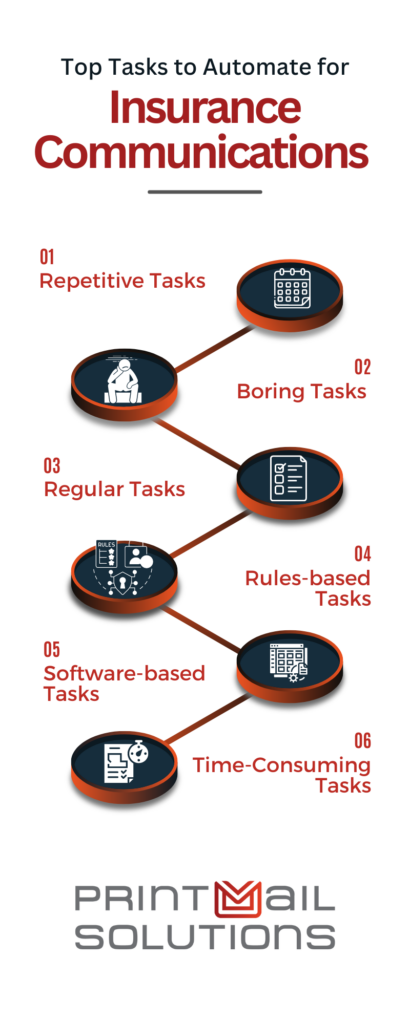It may be the ultimate paradox of our time. Technology has enabled us to be more connected than ever before, yet we communicate less and less personally, with friends, family, and with our customers. And so, while the need for information has remained the same, the forums and best practices for these exchanges have most certainly shifted, often removing the human element in the interest of speed and consistency.
In the insurance industry specifically, the opportunities for engagement have grown exponentially. Common communication touch points for clients now typically include mail (both through email and direct mail), websites, social media, texts, video conferencing, and chat. Keeping all of those avenues aligned in terms of core message, design, and goals while also being relevant to users from all walks of life is no easy task. Thankfully, technology provides an answer to the challenges it has created – automation.

The Case for Automation
“Almost all quality improvement comes via simplification of design, manufacturing, layout, processes, and procedures.” -Tom Peters
An all-too-common thought in our modern world is, “I could accomplish so much if I didn’t have to do this or that task.” Usually, the tasks being referred to are seemingly menial, often low value “nuts and bolts” type activities. They are puzzle pieces to the bigger picture, but can seem distant from the goal line and, to be honest, don’t often spark joy or feel fun to do.
So, while the emotional tugs are there, what needs to be tackled next is crafting a business case. Thankfully, too, this is well-worn ground. We all grew up with the story of Henry Ford’s development of the assembly line. His innovation streamlined the production of cars from days down to hours, thus ushering in the automotive era. But how does that relate to an industry like insurance? Can similar innovation lead to gains in productivity and an improved customer experience?
According to software company FORTNA, “(a)n effective automation business case must address these and other factors,” which include:
- Does the automation address key business priorities (customer satisfaction, delivery guarantees)?
- What are the risks of automation?
- What are the alternatives to automation to consider?
- How dependable is the data used for the business case analysis?
- What is the cost of doing nothing?
Although answers to the above will vary by organization, here are a few quick thoughts we have on the list.
- Communicating important information promptly is likely a business priority, and so ticking that box off is easy.
- While there are risks to automation, the opposite – human intervention – is not necessarily less risky, and some may argue the potential lack of consistency and opportunity for “human error” make it riskier.
- Partnering with PrintMail to handle insurance digital marketing and communication efforts provides a simple and effective way to mitigate risk while expanding capabilities.
- PrintMail can help you with data integrity as well, helping to ensure overall success.
- The cost of doing nothing is potentially huge, as it would require an outsized increase in hiring to stay ahead of the tipping point where the system breaks completely.
 What to Automate for Insurance Communications
What to Automate for Insurance Communications
The first rule of any technology used in a business is that automation applied to an efficient operation will magnify the efficiency. The second is that automation applied to an inefficient operation will magnify the inefficiency.” – Bill Gates
In the process of identifying what could or should be automated, technical writer (and yogi) Lorena Ciutacu offers a list of the types of tasks that can be automated.
- Repetitive Tasks
- Boring Tasks
- Regular Tasks
- Rules-based Tasks
- Software-based Tasks
- Time-Consuming Tasks
The increasing development and adoption of automation technologies like AI and RPA (Robotic Process Automation) will allow even more items to fall into the “boring” and “regular” categories, expanding the scope of what can and should be automated to allow humans to focus on their highest-value tasks.
Knowing this, what areas of the insurance industry can be automated?
- Claims Processing: Automation streamlines the claims process, reduces manual work by 80%, and significantly improves accuracy, benefiting both the insurer and customer.
- Policy Management: Automation in policy issuance and updates can drastically reduce manual labor, ensuring faster and more accurate policy management.
- Regulatory Compliance: Automated systems efficiently handle compliance checks and client data validation, enhancing security and compliance with fewer errors.
- Underwriting: Automation accelerates the underwriting process, improving accuracy and speed by handling data collection, analysis, and processing with minimal manual intervention.

What Not to Automate
In the original Jurassic Park, Jeff Golblum’s character delivered one of the most memorable lines in movie history when assessing the effects of bringing long extinct dinosaurs back to life. “Your scientists were so preoccupied with Whether or not they could, they didn’t stop to think if they should.” There is a temptation to consider automation as the panacea for everything, but there are most certainly areas within the insurance experience that should not be left to machines.
- The Human Element: Despite the benefits, a personal touch in insurance remains crucial. Automation should not replace human interactions entirely but enhance the customer service experience by freeing up human agents to handle more complex inquiries and provide personalized service.
- According to a study by J.D. Power, 74% of consumers research insurance purchases online, but only 25% end up making a purchase online. The ability to speak with a live agent is still a valued, if not integral, part of the process.
- Complex Decision-Making: While AI and RPA can significantly reduce the time spent on data processing and increase decision-making speed, complex and nuanced decisions should still involve experienced professionals to ensure accuracy and maintain trust.
Implementing Automation: Best Practices for Insurance Agencies
With the case for automation made, we can shift our conversation to the realities of bringing these resources online. To do so requires some work, often best approached as part of an exploration process with PrintMail Solutions.
- Identify Pain Points: Start by identifying processes that fall into the categories noted above, especially ones that are repetitive and time-consuming, which can benefit the most from automation.
- Pilot Programs: Begin with pilot programs to test and refine automation strategies before full-scale implementation. A/B testing (including human vs. automated completion of tasks),
- Human in the Loop: Ensure that automated processes include a mechanism for human intervention when necessary, maintaining a balance between efficiency and personalization. Also, consider that a segment of your client base will always be resistant to technology. You can read our recent blog post about addressing this challenge.

Customer Communications in Insurance Continue to Evolve
As society becomes increasingly technologically savvy, we have come to expect more from almost all of our experiences and interactions. To borrow the title of Charles Duhigg’s NY Times bestselling book, we expect almost all things to be the proverbial, “Smarter. Faster. Better.” It is reasonable to expect customer communication management styles and methods to continue to evolve and likely at a quickening pace. So how do we keep up?
Bolden Your Communications Strategy with PrintMail Solutions
PrintMail Solutions can help you stay ahead of the curve, providing clients with solutions to enhance their customer communication strategies and stay competitive in a rapidly evolving industry. Connect with our team to learn more about how a partnership with PrintMail can transform your customer communications and marketing efforts and be sure to subscribe to our blog for more great articles on improving customer relationships.
